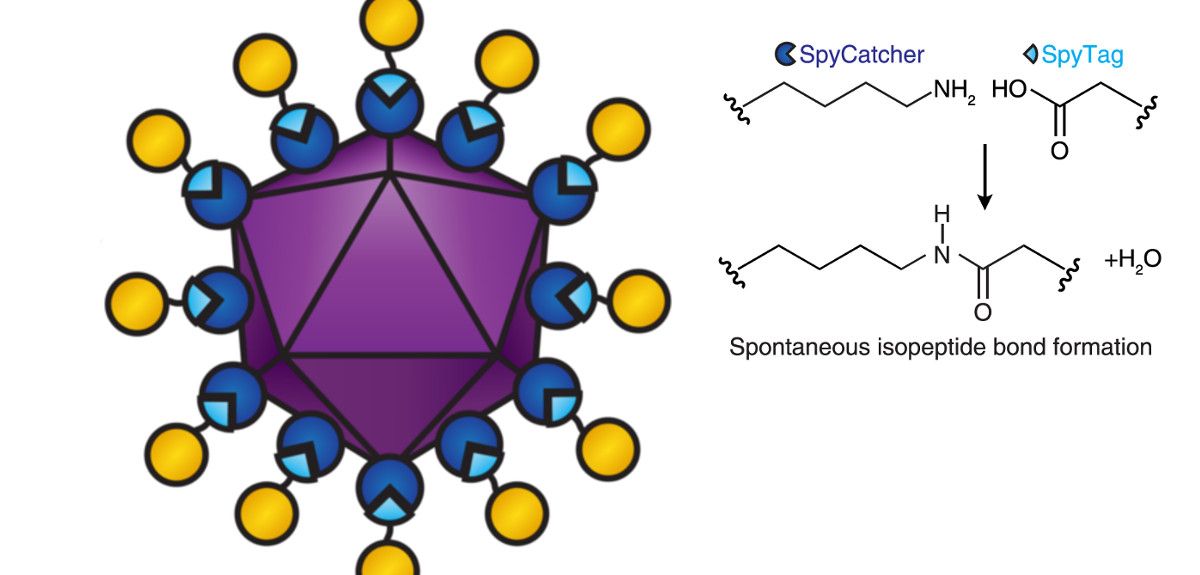
Image credit: Nature Scientific Reports (Used under a Creative Commons Attribution 4.0 International License CC-BY)
Synthetic biologists use bacterial superglue for faster vaccine development
An interdisciplinary team of Oxford University researchers has devised a new technique to speed up the development of novel vaccines.
Many vaccines are based around virus-like particles (VLPs). VLPs resemble viruses, but importantly don't carry pathogenic genetic material and thus cannot cause disease. These particles are engineered to display one part of a pathogen to the immune system, which can elicit strong protection upon any subsequent exposure to that pathogen.
A more reliable way of assembling candidate vaccines could make them much cheaper and improve the chances of vaccines against these illnesses.
Dr Darren Leneghan, The Jenner Institute
Karl Brune, leading the work in Professor Mark Howarth's lab in Oxford’s Department of Biochemistry explained: 'Current techniques to develop VLP-based vaccines take time and do not always work. Whilst getting the pathogen parts to stick to the carrier VLP, often problems such as misassembly or misfolding arise that make the vaccine ineffective at generating protective immunity.'
This failure rate translates into high development costs in trying to create vaccines against major diseases such as malaria, HIV and cancer.
'A more reliable way of assembling candidate vaccines could make them much cheaper and improve the chances of vaccines against these illnesses. A faster way of assembling vaccines may also help with the rapid development of new vaccines against unforeseen disease outbreaks.', says Dr Darren Leneghan, leading the immunisation work with Dr Sumi Biswas and Professor Simon Draper in Oxford's Jenner Institute, which specialises in vaccine development.
Karl Brune’s work has now overcome this key challenge in vaccine assembly using the lab's 'bacterial superglue'. This glue is made of two parts, a larger protein called SpyCatcher and a smaller protein part named SpyTag, both engineered from the bacterium Streptococcus pyogenes. When SpyTag and SpyCatcher meet, they form an unbreakable bond. The team succeeded in biologically encoding SpyCatcher on VLPs, which now enables scientists and engineers easily and relatively quickly to glue proteins with the small SpyTag to the SpyCatcher-VLPs.
Karl Brune said: ‘We tested the SpyCatcher-VLP – SpyTag-antigen combination using a range of malarial and cancer-relevant antigens. This showed that linking can be done simply and quickly to produce stable vaccines that generated robust antibody responses.
'We need to do more research, both to see if we can use Tag/Catcher fusion with other diseases and to test effectiveness in live rather than lab conditions.'
The team say that their technique should speed up developing new vaccines and also may help other medical applications of nanoparticles.
The paper, Plug-and-Display: decoration of Virus-Like Particles via isopeptide bonds for modular immunization, is published in the journal Scientific Reports (DOI: 10.1038/srep19234).
 New analysis of archaeological data reveals how agriculture and governance have shaped wealth inequality
New analysis of archaeological data reveals how agriculture and governance have shaped wealth inequality
 Cambridge victorious in Women's and Men's Boat Races 2025
Cambridge victorious in Women's and Men's Boat Races 2025
 Expert Comment: Ethical and legal challenges of uterus transplants in Mexico
Expert Comment: Ethical and legal challenges of uterus transplants in Mexico